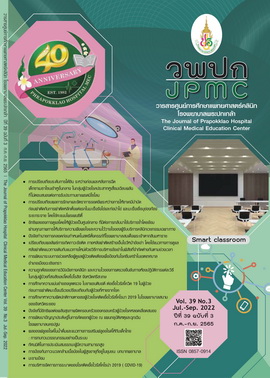Fluoride in Drinking Water : A Systematic Review
Main Article Content
Abstract
Dental caries is a major public health problem in developing countries, including Thailand. Water fluoridation has been widely implemented worldwide for several decades and evidence shows it reduces the prevalence of dental caries. World Health Organization recommending water fluoridation wherever it is politically and technically feasible. This study is a systematic review of the literature based on documented research on fluoride in drinking water. A total of 20 studies. The result have shown that water fluoridation has been shown to reduce dental caries by up to 35% in deciduous teeth and permanent teeth in children. Water fluoridation at the optimal concentration of 0.7 ppm is safe regarding the severity of the resulting fluorosis. There is no evidence that fluoride in water at optimal concentration causes any other systemic effects on humans. Factors that should be considered to implement a water fluoridation program relies upon an understanding of oral health behaviors of the population, diet and water consumption, the availability of other caries‐prevention strategies and population movement/migration. Most studies indicated that community water fluoridation remains highly cost-effective and equitable public health intervention. Water fluoridation is also exceptional in being an untargeted intervention that narrows the usually intractable health gap between different ethnic and socio-economic groups.
Article Details

This work is licensed under a Creative Commons Attribution-NonCommercial-NoDerivatives 4.0 International License.
References
Browne D, Whelton H, O'Mullane D. Fluoride metabolism and fluorosis. J Dent 2005;33:177-86
Villa A, Anabalon M, Zohouri V, Maguire A, Franco A.M, Rugg-Gunn A. Relationships between fluoride intake, urinary fluoride excretion and fluoride retention in children and adults: an analysis of available data. Caries Res [Internet] 2010;44:60-8
Iheozor-Ejiofor Z, Worthington HV, Walsh T, O'Malley L, Clarkson JE, Macey R, et al. Water fluoridation for the prevention of dental caries. Cochrane Database Syst Rev [Internet].2015 [cited 2022 Jan 10]. Available from: https://doi.org/10.1002/14651858.cd010856.pub2
Wordley V, Bedi R. A review of water fluoridation implementation strategy in England 2002–2005.BMC Oral Health [Internet]. 2020 [cited 2022 Jan 10]; 20(1):105. Available from: https://doi.org/10.1186/s12903-020-01102-w
Stangvaltaite-Mouhat L, Puriene A, Stankeviciene I, Aleksejuniene J. Fluoride in the drinking water and dental caries experience by tooth surface susceptibility among adults. BMC Oral Health [Internet]. 2021 [cited 2022 Jan 10]; 21(1):234. Available from: https://doi.org/10.1186/s12903-021-01598-w
Batsos C, Boyes R, Mahar A. Community water fluoridation exposure and dental caries experience in newly enrolled members of the Canadian Armed Forces 2006-2017. Can J Public Health 2021;112:513-20.
Das G, Tirth V, Arora S, Algahtani A, Kafeel M, Alqarni AHG, Et al. Effect of fluoride concentration in drinking water on dental fluorosis in Southwest Saudi Arabia. Int J Environ Res Public Health [Internet]. 2020 [cited 2022 Jan 10]; 17(11):3914. Available from: https://doi.org/10.3390/ijerph17113914
Jullien S. Prophylaxis of caries with fluoride for children under five years. BMC Pediatr [Internet]. 2021[cited 2022 Jan 10]; 21(Suppl1):351.Available from: https://doi.org/10.1186/s12887-021-02702-3
Chuah CJ, Lye HR, Ziegler AD, Wood SH, Kongpun C, Rajchagool S. Fluoride: A naturally-occurring health hazard in drinking water resources of Northern Thailand. Sci Total Environ [Internet]. 2016 [cited 2022 Jan 10]; 545-546:266-79. Available from: https://doi.org/10.1016/j.scitotenv.2015.12.069
Sawangjang B, Hashimoto T, Wongrueng A, Wattanachira S, Takizawa S. Assessment of fluoride intake from groundwater and intake reduction from delivering bottled water in Chiang Mai Province, Thailand. Heliyon [Internet]. 2019 [cited 2022 Jan 10]; 5(9):e02391. Available from: https://doi.org/10.1016/j.heliyon.2019.e02391
Cho MS, Han KT, Park S, Moon KT, Park EC. The differences in healthcare utilization for dental caries based on the implementation of water fluoridation in South Korea. BMC Oral Health [Internet]. 2016 [cited 2022 Jan 10]; 16(1):119. Available from: https://doi.org/10.1186/s12903-016-0311-z
Mariño R, Zaror C. Economic evaluations in water-fluoridation: a scoping review. BMC Oral Health [Internet]. 2020[cited 2022 Jan 10]; 20(1):115. Available from: https://doi.org/10.1186/s12903-020-01100-y
Moore D, Poynton M, Broadbent JM, Thomson WM. The costs and benefits of water fluoridation in NZ. BMC Oral Health [Internet]. 2017 [cited 2022 Jan 10]; 17(1):134. Available from: https://doi.org/10.1186/s12903-017-0433-y
Cury JA, Ricomini-Filho AP, Berti FLP, Tabchoury CP. Systemic effects (risks) of water fluoridation. Braz Dent J [Internet]. 2019 [cited 2022 Jan 10];30(5):421-8. Available from: https://doi.org/10.1590/0103-6440201903124
Chen KJ, Gao SS, Duangthip D, Lo ECM, Chu CH. Early childhood caries and oral health care of Hong Kong preschool children. Clin Cosmet Investig Dent [Internet]. 2019[cited 2022 Jan 10]; 11:27-35. Available from: https://doi.org/10.2147/ccide.s190993
Mookajornphan D. The importance of fluoride in drinking water and food. Quality 2009;146:93-5.
MongkolchaiAranya S, Rityu A. Guidelines to manage high fluoride in drinking water to prevent dental fluorosis. Bangkok: Dental Health Division, Department of Health, Ministry of Public Health; 2005.
Asa P, Chotikawin R, Suwannahong K, Pibanwong M. Situation quality of drinking water in primary schools, Chonburiprovince. KKU Research Journal 2021;21:222-32.
Dental Association of Thailand. Guidelines for the use of fluoride for children [Internet]. 2017. Available from: https://www.thaidental.or.th/main/download/upload/upload-20190213213340.pdf

